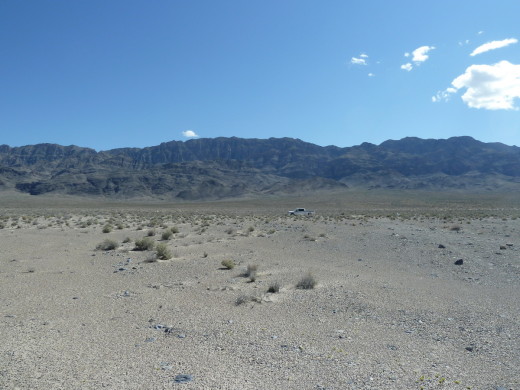A glint against the distant hills caught U.S. Fish & Wildlife Officer Walter Duran’s eye as we drove up the dirt road through Desert National Wildlife Refuge in southern Nevada. To check it out, Walter veered off onto the next side road heading in the direction of the still visible glimmer.
“That’s what we do,” Walter told me. “Always looking around for something different.”
My Opportunity
When Walter had invited me to ride along with him for the day, I jumped at the opportunity. It would give me the chance to see first hand the duties of law enforcement officers on a national wildlife refuge.
This day Walter was driving Alamo Road, a 72 mile rough dirt road through much of the largest national wildlife refuge in the continental United States. Only high clearance vehicles are allowed on this old wagon road that dips and curves in many areas, as well as leading to and through a dry lake bed 42 miles north of headquarters.
[twocol_one]
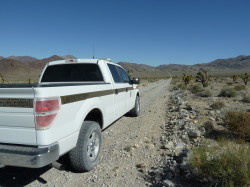
[/twocol_one] [twocol_one_last]
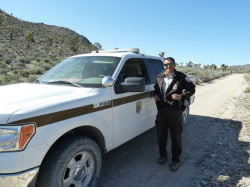
[/twocol_one_last]
After tracing the glinting object to a parked car, Walter determined that no one was in need of help. “Our job,” said Walter, “is to make sure people are okay and make sure the resources are okay. No off-roading, no target shooting.”
I glanced back at the two rifles secured to the Plexiglas window separating our front seats from the back seats of the truck. A Bushmaster 223 (a version of the M16) and a Remington 870 shotgun were close at hand. Although Walter has never had to use them on duty, he needs to qualify with them every six months just in case he encounters a problem that would require using them.
Dry Lake Bed
About 40 miles into the old wagon road the dry lake bed came into view. On dry days, the road is likely passable. But because several people have driven into the sandy lake bed and become stuck in their vehicles, the road has been closed to through traffic. With no cell coverage and a 40 mile walk to help, the consequences of becoming stranded could be fatal.

This day we followed fresh tire tracks leading beyond the “Road Closed” sign. In the distance, Walter spotted a trail of dust. He held binoculars to his eyes to spot the offender, then speeded up to try to catch him.
[twocol_one]
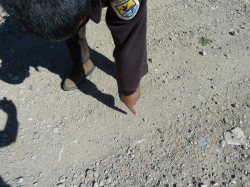
[/twocol_one] [twocol_one_last]

[/twocol_one_last]
A few minutes later, Walter pulled his truck behind a parked SUV. Its driver was already beginning a hike toward the hills. Walter signaled him back with a short siren blast and explained that he had entered a closed area.
[twocol_one]

[/twocol_one] [twocol_one_last]
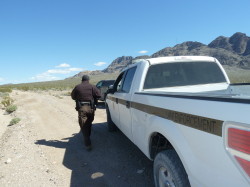
[/twocol_one_last]
“I know,” the man said, “but I knew I could make it with my car.” After more discussion regarding refuge rules, as well as comparing tire sizes for their vehicles and various other chit chat, Walter merely issued the man a warning. His handling of the situation not only let the visitor know that law enforcement is visible on the Refuge, but also helped deliver valuable information about the Refuge to the visitor.
“If people don’t know about Fish and Wildlife Service,” said Walter, “how is the Service going to get support?”
Fly the Flag
“What we do is fly the flag, so to speak,” says Law Enforcement Supervisor Rob Peloquin. “We are a visible deterrent that makes people think twice about misbehaving. It’s called proactive law enforcement, in which we contact visitors and talk with them. And through that, it prevents violations.”

The remainder of the day with Walter led us to the end of the dirt road from Desert National Wildlife Refuge into adjoining Pahranagat National Wildlife Refuge where Walter spent a couple hours greeting campers, checking fishing licenses, and encouraging drivers to obey the 10 mph speed limit.
When Walter stopped one SUV with a man and woman in the front seats to let them know that they were traveling too fast, a child popped up from the back seat. “Oh,” exclaimed Walter, “there’s a little one!” Walter asked the youngster if he would like to be “Officer for the Day.” When the child nodded enthusiastically, Walter then instructed him, “Now be sure your dad doesn’t go too fast!” Mother and Father in the front seats chuckled at the gesture before continuing into the campground at the required speed.
“Law enforcement,” says Rob Peloquin, “is a small component of Fish and Wildlife Service. I try to put it in language that the visitor can understand. It’s like endangered species – you recover the species so you can move into a pure monitoring phase. Law enforcement on a National Wildlife Refuge has the same goal – you’re trying to gain voluntary compliance from the public so you can fall into a monitoring phase.”
Ambassadors for the Refuge System
My day with Walter reinforced what I had pictured law enforcement accomplishing on a refuge. Walter was polite, interactive, and instructive, a true ambassador for the refuge system. The next weekend, when I had an opportunity to accompany Rob on his rounds to Ash Meadows National Wildlife Refuge, I discovered the same attitudes. As an added bonus, besides his law enforcement training, Rob has a degree in biology and interacts with visitors from that aspect as well.
“I can talk with visitors and enhance their experiences,” says Rob. “Law Enforcement is the face of the agency. We contact visitors even on weekends; others don’t have that same contact opportunity. I work for the right agency, and I love what I do!”

